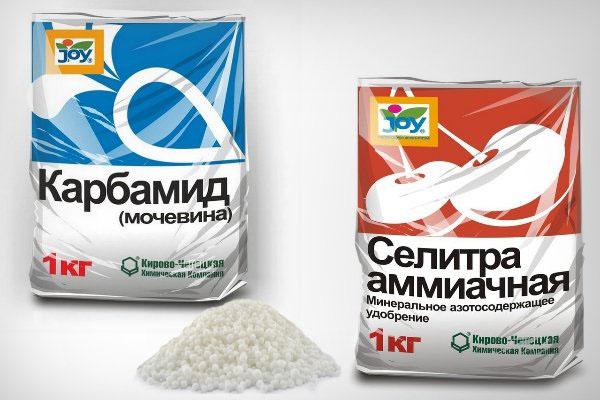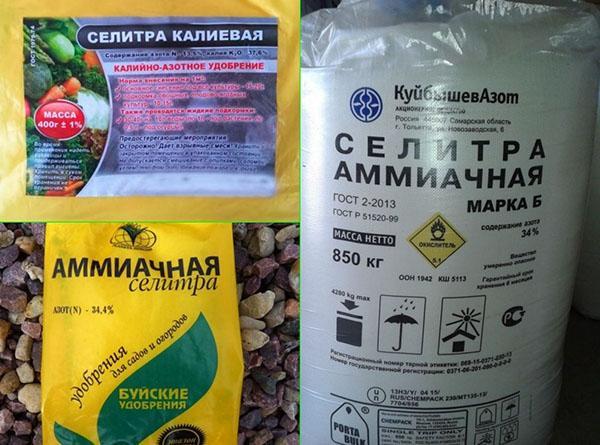It is important to know - how is nitrate different from urea?
 The cultivation of vegetables, herbs and fruits is accompanied by comprehensive care, an obligatory part of which is feeding with fertilizers containing nitrogen. Let's figure out how saltpeter differs from urea, and how to use them correctly when caring for different crops.
The cultivation of vegetables, herbs and fruits is accompanied by comprehensive care, an obligatory part of which is feeding with fertilizers containing nitrogen. Let's figure out how saltpeter differs from urea, and how to use them correctly when caring for different crops.
Saltpeter: types, application

This word itself is a generalized concept, so we should talk about what kind of saltpeter is. Manufacturers distinguish four types of dressings of this type. When using them, it is important to understand for what purposes they are used and in what quantity. Fertilizer can be harmful if applied too actively and in large quantities.
The types of nitrate and their use are indicated in the table below:
| № | View | Formula | Application |
| 1 | Potash | KNO3 | for feeding crops that cannot tolerate chlorine (berries, root crops); potassium promotes root formation |
| 2 | Calcium | Ca (NO3)2 | on acidified soils and for feeding winter crops in spring |
| 3 | Ammonia | NH4NO3 | fertilization of crops on any soils and use as an integral part of complex fertilizers |
| 4 | Sodium | NaNO3 | fertilization of plants on all types of soils except salt marsh |
All types of nitrate are hygroscopic, that is, they perfectly absorb moisture, which affects the quality of the product. It is recommended to store it in a dry place.
The most common fertilizer used in agriculture is "ammonium nitrate". It is convenient to use: getting into wet soil in spring, it is quickly absorbed without causing damage to the environment. It is produced in the form of fine crystalline salt or granules. It is also used in dissolved form.
The nitrogen content in ammonium nitrate is up to 35%. If the soil is too wet, swampy areas are observed, nitrogen can be washed out of it.
Application rules

This type of fertilizer has a number of positive qualities:
- plant nutrition;
- protection against pathogenic bacteria and viruses;
- long-term preservation of fruits;
- accelerated growth.
There are also disadvantages when using it: the danger of acidification of soils with an elevated pH, the impossibility of using it for a number of crops due to the accumulation of nitrates in fruits.
Ammonium nitrate is a fertilizer not recommended for use at the end of summer, since it will provoke shoot growth and a decrease in the quality of the fruit.
The use of nitrogen-containing fertilizers is carried out strictly according to the instructions with a preliminary assessment of the quality of the soil. You should carefully read the recommendations on the packaging. For depleted poor lands, an average of 40 g of substance per 1 m is taken2... For comparison - for rich soils do not use more than 30 g for the same area.
The use of ammonium nitrate in the country is recommended. If the soil has increased acidity, calcium carbonate is additionally introduced, it neutralizes the acid.
Saltpeter is a flammable substance. It must be stored away from open flames, fuel, and any highly flammable materials.
Urea: types, application
 Before we figure out how nitrate differs from urea, let's figure out what carbamide is. Like saltpeter, it is widely used as a universal fertilizer.Outwardly, it is white granules, sometimes translucent.
Before we figure out how nitrate differs from urea, let's figure out what carbamide is. Like saltpeter, it is widely used as a universal fertilizer.Outwardly, it is white granules, sometimes translucent.
Urea, like saltpeter, contains an important element that contributes to the rapid growth and fruiting of the plant - nitrogen. The formulas for ammonium nitrate and urea are different. Urea ((NH2)2CO), the nitrogen content in it reaches 46%. This significantly exceeds the indices of nitrate.
There are two types of products:
- grade A;
- B.
Not everyone knows how urea grade A and B differ. The difference is insignificant: the mass fraction of biuret for grade A is from 0.6 to 1.4%, the nitrogen content in it is about 0.1% higher. Biuret is a toxic substance. At its high concentration, plant growth is inhibited. For this reason, the use of urea is carried out strictly according to the instructions.
Urea of grade B is sold as a fertilizer, while the other is used for industrial production.
The substance does not absorb moisture from the air, therefore, when stored in a dry room, it does not cake, it is fireproof, easily soluble in water.
Application rules
 The high nitrogen content requires the gardener to strictly adhere to the fertilizer dilution proportions. A number of crops are demanding in terms of growing conditions and feeding.
The high nitrogen content requires the gardener to strictly adhere to the fertilizer dilution proportions. A number of crops are demanding in terms of growing conditions and feeding.
Urea is used:
- diluted;
- dry.
Surface application of urea is not advisable, since ammonia evaporates quickly in air. To obtain the desired effect, it is required to embed the granules into the ground to a depth of 4-5 centimeters.
If it is planned to plant crops that do not tolerate biuret, the introduction of urea should be carried out 2 weeks before sowing. The substance will evaporate from the soil.
What is the difference between nitrate and urea
It's time to find out what is the difference between urea and saltpeter. On the one hand, both substances are a universal top dressing for garden and summer cottages, they can be used by flower growers, including for fertilizing indoor plants... Their cost is acceptable, it is not difficult to find on sale. However, there are differences.
Urea contains more nitrogen, but its consumption per 100 m2 is 1.3-2 kg. Average consumption of nitrate - 1 kg per 100 m2.
 Urea is a gentle fertilizer and is widely used for foliar dressing. During the growing season of plants, it is introduced into the soil without fear for plants. Saltpeter is an aggressive mineral that, if applied incorrectly, can damage the plant. It cannot be used during the period of fruit formation.
Urea is a gentle fertilizer and is widely used for foliar dressing. During the growing season of plants, it is introduced into the soil without fear for plants. Saltpeter is an aggressive mineral that, if applied incorrectly, can damage the plant. It cannot be used during the period of fruit formation.
The use of ammonium nitrate for cucumbers, pumpkins, squash, zucchini is not recommended as these plants accumulate nitrates.
The process of saturation of the soil with nitrogen is also different. In the case of using nitrate, this happens quickly, urea - slower, but longer.
The use of saltpeter for grain crops is widespread, because it has the property of "burning through" layers of snow. Urea is more difficult to introduce, the organic compound is afraid of high temperatures.
 In spring, additional protection of plants from pests... Spraying trees with ammonium nitrate is an opportunity to saturate them with nitrogen and save them from uninvited guests. Carbamide is also suitable for this, but it is used after the first green leaves appear, when the air has already warmed up. The substance is diluted in water. It will not harm the leaves, unlike mineral fertilizers. The use of ammonium nitrate for treating trees is justified only in early spring.
In spring, additional protection of plants from pests... Spraying trees with ammonium nitrate is an opportunity to saturate them with nitrogen and save them from uninvited guests. Carbamide is also suitable for this, but it is used after the first green leaves appear, when the air has already warmed up. The substance is diluted in water. It will not harm the leaves, unlike mineral fertilizers. The use of ammonium nitrate for treating trees is justified only in early spring.
 Florists are well aware of the properties of both substances. Top dressing is recommended twice a year. This will enhance growth, the plant will respond with flowering. The use of ammonium nitrate for flowers, including indoor flowers, is more common. There is no danger in this.
Florists are well aware of the properties of both substances. Top dressing is recommended twice a year. This will enhance growth, the plant will respond with flowering. The use of ammonium nitrate for flowers, including indoor flowers, is more common. There is no danger in this.
Replacing fertilizers containing nitrogen
Sometimes gardeners and truck farmers have the question of how nitrogen fertilizers can be replaced. Their use on acidic soils is limited, in some countries it is quite difficult to find saltpeter.
Urea is primarily used as a substitute for nitrate. In its absence:
- ammonium sulfate;
- ammonium chloride;
- any other types of saltpeter.
If you need to find a fertilizer that can replace urea, use any of the above.
To grow a rich harvest or achieve great flowering in the garden, you should be smart about the choice and use of universal fertilizers. This will allow you not to harm the soil, provide the plants with proper care. Knowing how urea differs from nitrate, it is easy to make a choice.